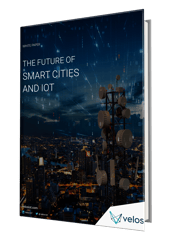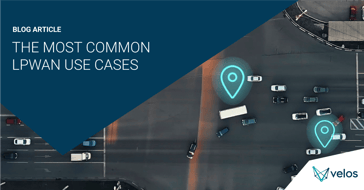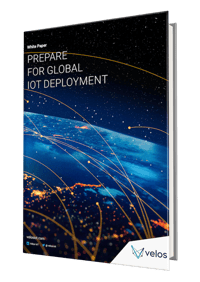The 5 most important elements of connectivity
IoT Connectivity is a broad and complex topic, making it sometimes challenging to know the key to consider when making connectivity decisions for your business.
To help you on your way, we'll cover the most important elements of IoT connectivity in this quick guide to help you make the right choice for your unique connectivity needs. Here are the five most important questions you should ask yourself when deploying connected devices:
1. Power consumption: how much battery does it consume?
Whether your IoT devices will be plugged in 24/7, rechargeable, or replaceable, power consumption and battery life will play a key role in the connectivity your project uses. The type of usage, the location of the device and the size of the battery will all drive your choice of IoT connectivity.
2. Range: how wide is the area it covers?
Some projects will need as much range as possible, while others may be able to get it by using interconnected Bluetooth networks. Signal strengths differ, so you need to know how much range you need to be covered before choosing a connectivity solution, as this will impact other key considerations such as power consumption and cost.
3. Bandwidth: how much data does it transmit?
Most current IoT applications only need to transmit small amounts of data at a time, but as more sophisticated devices penetrate the market, the more complex the IoT projects become. It is important to know how much data your devices will transmit and how frequently so you can choose between high-volume IoT and LPWA networks suitable for low power and low data consumption.
4. Reliability: how reliable do I need my network to be, and with what coverage?
Regardless of the size, goals, and lifespan of your IoT project, network reliability and reliance are key. The more downtime your network has, the less "Internet" your Internet of Things is going to have. For critical IoT deployments, such as medical devices, health trackers, safety monitors and rescue drones, for example, a single network failure may lead to the loss of human life. Other projects, such as asset tracking for logistics, require cross-border network coverage but do not necessarily need real-time data 24/7. Before selecting your IoT connectivity plan, think about where you would need to connect and what your network fallback options are in case of an emergency.
5. Cost: how expensive is the connectivity?
Because of the large-scale and often global nature of IoT projects, connectivity can quickly (and likely will) become expensive. When comparing providers, make sure that you're getting the connectivity you need for a price that suits your budget without compromising on any of the other factors, especially reliability. Network pricing and access change regularly, so make sure you choose a provider that can offer you not only flexible pricing options but good network availability in the regions you operate in, so you can always have option B in case your primary network becomes too expensive or unavailable.
Which connectivity solution is right for your IoT project?
In a perfect world, the perfect connectivity solution would have low-power consumption, wide-area coverage, high data throughput bandwidth, be extremely reliable and low cost. Unfortunately, the technology isn't quite there yet, but there are solutions tailored to suit the most common use cases.
When choosing IoT connectivity, it is important to know if your IoT project is going to be made up of mobile or fixed assets. How spread out your devices are, for example, if they’re in one location or distributed internationally, and where they are physically located - indoors, underground, outside, etc., will also play a key role in the decision-making process.
The different types of IoT Connectivity technologies
- LTE Advanced
A faster and more reliable version of standard LTE, LTE Advanced is great for projects that need the fastest response times, like autonomous vehicles. - LTE Cat.0
For IoT projects with limited network needs, there's Cat.0. It has bare-minimum features (in the good sense!), with a low cost and high reliability. - LTE Cat-M
The second generation of Cat.0 - Cat M - is more effective and efficient, and most importantly, compatible with existing LTE networks. Using Cat M means you won't need to wait for infrastructure to catch up with your needs. - NB-IoT
Designed specifically for IoT, Narrowband or NB-IoT is long-range, consumes low power, and is immune to interference from other types of connectivity, making it extremely reliable.
 See detailed features of LTE, LTE-M and NB-IoT. Source: T-Mobile.
See detailed features of LTE, LTE-M and NB-IoT. Source: T-Mobile.
You might also be interested in:
Different LPWAN Technologies Explained
LTE-M and NB-IoT Explained Further
A brief guide to LPWAN (Low-Power Wide-Area Network)
- LoRa
LoRa (Long-Range) is a low-power, long-distance coverage solution. It's only capable of transmitting small data packets at a time, making it a cost-effective solution for most IoT projects.
Read on: What Are The Differences Between LoRaWAN And NB-IoT?
- 4G LTE
4G LTE is the current most widespread cellular technology, making it the go-to solution for high-demand networks. It's not very cost-effective, however, and is likely overkill for most IoT projects. - 2G and 3G
The previous generations of 4G cellular connectivity, these networks are still used today for devices like parking meters and vending machines. They can't transmit video, however, which is a limiting factor.
As a result of the rapid transformation of the cellular IoT technology landscape, 2G/3G networks are being

depopulated of IoT devices and eventually will be shut down completely. While IoT businesses should be
concerned and fast-acting regarding the sunsetting of 2G/3G, the situation isn’t wholly without opportunities. Newer LPWAN connectivity
technologies like CAT-M1 and NB-IoT are becoming the most affordable and suitable replacement for 2G/3G networks, making them more accessible to various IoT businesses.
To be prepared, businesses can make critical progress while upgrading to these newer networks as earlier as possible. Follow our recent global 2G/3G sunset updates page to plan your alternative replacement.

- 5G
5G is the next generation of 4G networks and has yet to become officially available. When it is released, however, it is believed that it will have IoT support incorporated in some way. - SigFox
SigFox is a connectivity provider aimed at the IoT market. Their connectivity solution is helpful for mobile devices with low-data needs, like smartwatches and smart meters. - Wi-Fi
Wi-Fi is great for devices in a fixed location with high data demands, but typically has a low range and unpredictable reliability. - ZigBee
ZigBee is a connectivity solution for smaller IoT projects in a contained area, like smart homes, that have low power and data needs. - Z-Wave
Similar to ZigBee, Z-Wave uses radio waves to create a short-range, low-data and power network for small IoT projects.
Connectivity requirements for different sectors
While every IoT project's needs are a little different, some general themes can be found in each industry. The technology is still new, but IoT has big implications for the way business is traditionally done. IoT networks will be able to cut costs and improve efficiency through automation, over-the-air updates, predictive maintenance, asset management, and remote monitoring.
Here are just a few of the different ways that IoT connectivity will differ from one industry to the next:
- Automotive and Industrial
Low bandwidth networks with medium to high ranges will be the most common in the automotive industry, with reliability being a critical issue. Similar applications are found for industrial IoT, where devices often use low-power wide area networks. - Agriculture
IoT in this industry will primarily be used for optimising yields and predicting maintenance, so low bandwidth, low range networks are all that is required.
Read more on IoT connectivity in Agriculture:
Connectivity & Agriculture: Why IoT is key to the future of farming?
Precision Farming - IoT Applications in Agriculture
- Cities
Due to their size and needs, smart cities need IoT networks with a longer range that are highly reliable, with bandwidth typically being low, depending on the needs of the particular city.
- Utilities
Because utility devices will be spread across a large geographic location, long-range and high reliability is required. - Transport and Logistics
IoT in transport will be primarily used for tracking and logistics optimisation, so a long-range with low bandwidth will be needed by most in this sector. Read on> - Healthcare
Most healthcare IoT networks will only consume a low amount of data in a short range, with medium reliability needs. - Construction
Because construction projects usually take place in one fixed location, a low bandwidth, short-range, and decently reliable network is all that is required. Read on > The diversity of LPWAN technologies allows for its application across various domains, driving innovation and transforming industries. Each technology has its own features, advantages, and deployment scenarios. IoT applications need to choose the most suitable option based on their requirements.Let us explore some of the most common LPWAN applications across the industries below. Read on >
The diversity of LPWAN technologies allows for its application across various domains, driving innovation and transforming industries. Each technology has its own features, advantages, and deployment scenarios. IoT applications need to choose the most suitable option based on their requirements.Let us explore some of the most common LPWAN applications across the industries below. Read on >
Factors to consider when choosing IoT Connectivity
Since the IoT connectivity market is still fairly new, picking the right provider requires both careful consideration and judgement. Not all IoT connectivity solutions are completely developed, implementing your desired network could require you to invest in the development of infrastructure – in turn, adding to the overall cost of connectivity. It is also worth considering the accessibility of different connectivity solutions.
The key takeaway here is to closely consider the price of the connectivity solution you want to use, as well as the availability of any provider. Below are some things to keep in mind when considering your options:
- Price does not necessarily reflect coverage
Unlike consumer networks, where most of the premium you pay goes towards coverage – IoT network pricing is based on a number of different features such as your network types, coverage zones and implementation testing. - Security
Like any network of data-sensitive devices, your connectivity provider needs to be secure. Otherwise, every device in your IoT network presents a potential risk. Choose a provider that can prevent threats before they get to your IoT network. - The quality of coverage
While keeping all of your devices connected is a good start, it's not enough to keep an IoT project sustainable. Your connectivity provider needs a solution that provides your devices with a strong, reliable connection – whether your devices are indoors or outdoors. - Multi-network roaming
Because of the mobile nature of most IoT networks, roaming connectivity is a must. And since no network has truly global coverage, you need a connectivity solution that allows you to roam multiple networks across different carriers. This way, even if your devices are outside of your home network’s range, they’ll still be connected. - Network resiliency
When things do go wrong, and your devices lose connectivity, how will it affect your data? How long will it take the network to recover? How much will be required of you to bring the network back online? If you're using a resilient network, the answer to all of these should be as close to “Zero” as possible.
Do you have the network resilience you need?
Network resilience is essentially your IoT network's ability to manage any roadblocks, such as network outages and self-heal. In other words, if something goes wrong with your network – how quickly and easily can the problem be restored?
In a network with poor resilience, an outage can become a serious problem. If handled poorly, it can result in a loss of data, security and resources. And network resiliency doesn't just refer to the frequency and severity of network outages, but also the quality of your network's coverage.
A resilient network will have reliable coverage across its ranges, meaning you won't have to worry about dead spots when deploying your devices. And in the event that something does go wrong, a resilient network will be able to manage the issue with little interference from you.
If you're trying to determine if your current/potential connectivity provider will offer you the network resiliency you need – just ask yourself these four questions:
Are your devices always accessible?
With a reliable network plan, you’ll be able to access your devices whenever you need them, wherever they are. You need a strong connectivity solution that keeps your devices available to you in every situation so that you’re never without critical data. Otherwise, your network is putting you at risk.
Do you have a recovery plan in place?
If disaster strikes, and you do lose connectivity/data/security – does your network provider have a Plan B? And if they do, make sure that they also have a Plan Z. You can never be too prepared.
Is your network secure?
IoT projects are – by their very nature – extremely data-sensitive. They are collecting a broad scope of information across hundreds, or even thousands, of devices. And each of those devices is a potential doorway into your IoT project. If a provider doesn't value network security, they're putting your project at risk.
Does your network deliver data accurately and consistently?
Lastly, you want to make sure that the quality of the network is up to par. Otherwise, you could be losing data, transmitting inaccurate data, or transmitting infrequently – all of which will greatly impair your project's effectiveness.

White paper: Preparing for Global IoT Deployments
Read our white paper to learn how you can prepare yourself for global IoT deployment at scale considering all above factors.
Finding a secure IoT network
Even for tech-savvy individuals, determining if a network is really offering you the security you need can be a challenging task.
Fortunately, just understanding the basics of IoT connectivity security – like the difference between public and private networks, for example – can make that decision process much easier.
A public network is one that anyone with the right hardware can connect to – like the internet! A private network, however, is members only. A familiar example of this would be most cellular networks, where you can only access them through a direct agreement.
While public networks are more affordable, they pose serious and obvious security risks. For a secure IoT network, therefore, private is the way to go:
VPN
A VPN (Virtual Private Network) is a network that acts as a middleman between your devices and the rest of the internet. Your device (which should be able to connect to the internet, with or without a VPN) passes all of its information through the VPN – keeping your data confidential and mostly secure.
APN
An APN (Access Point Name) is what directly connects your device to the internet. APNs are what keep smartphones from only connecting to networks they have permission to.
IPsec
IPsec (Internet Protocol Security) is a set of network security protocols that protect and encrypt data. Some form of IPsec is used in most VPNs as a means of securing transmitted data, ensuring that it cannot be read by any interceptor.
Want to learn more about Private APN and different IP models? Find out more in our IoT SIM Guide.
Choosing Velos IoT as your provider
If you're looking for the most reliable and flexible network for your IoT project – consider choosing Velos IoT as your connectivity provider. Our global network can keep your devices connected across 600+ roaming agreements in more than 200 countries and territories, ensuring your IoT devices will have consistent coverage no matter where they're deployed worldwide.
Velos IoT currently offers robust cellular IoT connectivity and has a roadmap in place for implementing LTE-M and NB-IoT networks as the technology progresses. We also have custom VPNs and APNs, so your devices won't be sharing traffic. Instead, they'll be on a unique network protected by telco-grade firewalls.
Conclusion
Deciding which network is right for your IoT project is an important step in making your IoT vision a reality. If you're looking for the most resilient, reliable, and secure network available, consider partnering with Velos IoT for your IoT connectivity needs.
To learn more about our IoT solutions, check out our Product Overview for further information or send us an enquiry today and one of our IoT experts will get in touch shortly.







